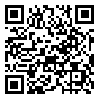1. Abolghasemi, A., Alah Gholilo, K., Narimani, M., & Zahed, A. (2011). [Emotion regulation strategies in stbstance abusers with high and low reactivity (Persian)]. Journal of Guilan University of Medical Sciences, 20(77), 15-22.
2. Ahmadi, J.(2000). Motivations for use of opiates among addicts seeking treatment in Shiraz. Psychological Reports, 87(7), 1158. doi: 10.2466/pr0.87.7.1158-1164 [
DOI:10.2466/PR0.87.7.1158-1164]
3. Aldao, A., Nolen Hoeksema, S., & Schweizer, S. (2010). Emotion-regulation strategies across psychopathology: A meta analytic review. Clinical Psychology Review, 30(2), 217–37. doi: 10.1016/j.cpr.2009.11.004 [
DOI:10.1016/j.cpr.2009.11.004]
4. Asgari, P., Pasha, G. R., & Aminiyan, M. (2009). [Relationship between emotion regulation, mental stresses and body image with eating disorders of women (Persian)]. Andisheh va Raftar (Applied Psychology), 4(13), 65-78.
5. Baker, T. B., Piper, M. E., McCarthy, D. E., Majeskie, M. R., & Fiore, M. C. (2004). Addiction motivation reformulated: An affective processing model of negative reinforcement. Psychological Review, 111(1), 33–51. doi: 10.1037/0033-295x.111.1.33 [
DOI:10.1037/0033-295X.111.1.33]
6. Taremian, F., Bolhari, J., Peiravi, H., & Tabatabaii, M. (2008). The prevalence of substance use among students in Tehran. Iranian Journal of Psychiatry and Clinical Psychology, 113(4), 335-42.
7. Brandon, T. H. (1994). Negative Affect as Motivation to smoke. Current Directions in Psychological Science, 3(2), 33–7. doi: 10.1111/1467-8721.ep10769919 [
DOI:10.1111/1467-8721.ep10769919]
8. Brunelle, C., Assaad, J. M., Barrett, S. P., Avila, C., Conrod, P. J., Tremblay, R. E., et al. (2004). Heightened heart rate response to alcohol intoxication is associated with a reward seeking personality profile. Alcoholism: Clinical & Experimental Research, 28(3), 394–401. doi: 10.1097/01.alc.0000117859.23567.2e [
DOI:10.1097/01.ALC.0000117859.23567.2E]
9. Dennhardt, A. A., & Murphy, J. G. (2013). Prevention and treatment of college student drug use: A review of the literature. Addictive Behaviors, 38(10), 2607–18. doi: 10.1016/j.addbeh.2013.06.006 [
DOI:10.1016/j.addbeh.2013.06.006]
10. Fox, H. C., Axelrod, S. R., Paliwal, P., Sleeper, J., & Sinha, R. (2007). Difficulties in emotion regulation and impulse control during cocaine abstinence. Drug and Alcohol Dependence, 89(2-3), 298–301. doi: 10.1016/j.drugalcdep.2006.12.026 [
DOI:10.1016/j.drugalcdep.2006.12.026]
11. Fox, H. C., Hong, K. A., & Sinha, R. (2008). Difficulties in emotion regulation and impulse control in recently abstinent alcoholics compared with social drinkers. Addictive Behaviors, 33(2), 388–94. doi: 10.1016/j.addbeh.2007.10.002 [
DOI:10.1016/j.addbeh.2007.10.002]
12. Gratz, K. L., & Roemer, L. (2004). Multidimensional assessment of emotion regulation and dysregulation: Development, factor structure, and initial validation of the difficulties in emotion regulation scale. Journal of Psychopathology and Behavioral Assessment, 26(1), 41–54. doi: 10.1023/b:joba.0000007455.08539.94 [
DOI:10.1023/B:JOBA.0000007455.08539.94]
13. Gratz, K. L., & Tull, M. T. (2009). The relationship between emotion dysregulation and deliberate self harm among inpatients with substance use disorders. Cognitive Therapy and Research, 34(6), 544–53. doi: 10.1007/s10608-009-9268-4 [
DOI:10.1007/s10608-009-9268-4]
14. Gross, J. J. (1998). The emerging field of emotion regulation: An integrative review. Review of General Psychology, 2(3), 271–99. doi: 10.1037/1089-2680.2.3.271 [
DOI:10.1037/1089-2680.2.3.271]
15. Habibzadeh, A., Alizadeh, M., Malek, A., Maghbooli, L., Shoja, M. M., & Ghabili, K. (2011). Illicit methylphenidate use among Iranian medical students: Prevalence and knowledge. Drug design, Development and Therapy, 5, 71-6. doi: 10.2147/DDDT.S13818 [
DOI:10.2147/DDDT.S13818]
16. Haji, A. K., Bahreynian, S., Naziri, G. H., & Modares, G. M. (2009). The role of cognitive variables, metacognitive dimensions and emotions in substance abuse behaviors. Advances in Cognitive Science, 11(3), 1-12.
17. Haj Seyyed Javadi, S. A. R., Mazinani, R., Fadaei, F., & Dolatshahi, B. (2007). The role of novelty and sensation seeking in opioid abuse and dependence. Archives of Rehabilitation, 8, 53-7.
18. Hassan Shahi, M. M., & Ahmadian, K. (2003). Mental health survey of psychoactive drugs-dependent patients. Journal of Fundamentals of Mental Health, 6(24), 131-9.
19. Johnson, A. L., & McLeish, A. C. (2016). The indirect effect of emotion dysregulation in terms of negative affect and smoking related cognitive processes. Addictive Behaviors, 53, 187–92. doi: 10.1016/j.addbeh.2015.10.023 [
DOI:10.1016/j.addbeh.2015.10.023]
20. Kober, H., & Bolling, D. (2014). Emotion regulation in substance use disorders. In J. Gross (Ed), Handbook of Emotion Regulation (pp. 428-46). New York: Guilford Publications.
21. Koob, G. (2001). Drug addiction, dysregulation of reward, and allostasis. Neuropsychopharmacology, 24(2), 97–129. doi: 10.1016/s0893-133x(00)00195-0 [
DOI:10.1016/S0893-133X(00)00195-0]
22. Krystal, H. (1978). Self representation and the capacity for self care. In D. L. Yalisove (Ed), Annual of Psychoanalysis (pp. 209-46). New York: NYU Press.
23. Merikangas, K. R., & McClair, V. L. (2012). Epidemiology of substance use disorders. Human Genetics, 131(6), 779–89. doi: 10.1007/s00439-012-1168-0 [
DOI:10.1007/s00439-012-1168-0]
24. O'Donohue, W. T., Fisher, J. E., & Hayes, S. C. (2004). Cognitive behavior therapy: Applying empirically supported techniques in your practice. New Jersey: John Wiley & Sons.
25. Shams, J., Azizi, A., & Mirzaei, A. (2010). Correlation between distress tolerance and emotional regulation with students smoking dependence. Hakim Research Journal, 13(1), 11-18.
26. Suh, J. J., Ruffins, S., Robins, C. E., Albanese, M. J., & Khantzian, E. J. (2008). Self medication hypothesis: Connecting affective experience and drug choice. Psychoanalytic Psychology, 25(3), 518–32. doi: 10.1037/0736-9735.25.3.518 [
DOI:10.1037/0736-9735.25.3.518]
27. Vazirian, M., & Mostashari, G. (2002). [Practical manual for treatment of substance abuse (Persian)]. Tehran: Porshokouh Pub.
28. Weed, N. C., Butcher, J. N., McKenna, T., & Ben Porath, Y. S. (1992). New measures for assessing alcohol and drug abuse with the MMPI-2: The APS and AAS. Journal of Personality Assessment, 58(2), 389–404. doi: 10.1207/s15327752jpa5802_15 [
DOI:10.1207/s15327752jpa5802_15]
29. Wilson Van Voorhis, C. R., & Morgan, B. L. (2007). Understanding power and rules of thumb for determining sample sizes. Tutorials in Quantitative Methods for Psychology, 3(2), 43–50. doi: 10.20982/tqmp.03.2.p043 [
DOI:10.20982/tqmp.03.2.p043]
30. Wong, C. F., Silva, K., Kecojevic, A., Schrager, S. M., Bloom, J. J., Iverson, E., et al. (2013). Coping and emotion regulation profiles as predictors of nonmedical prescription drug and illicit drug use among high-risk young adults. Drug and Alcohol Dependence, 132(1-2), 165–71. doi: 10.1016/j.drugalcdep.2013.01.024 [
DOI:10.1016/j.drugalcdep.2013.01.024]
31. Zargar, Y., Najarian, B., & Naami, A. (2008). The relationship between personality traits (sensation seeking, assertiveness, psychological hardiness), the religious attitude and marital satisfaction with readiness for drug abuse. Journal of Education and Psychology Chamran University, 1(3), 99-120.
32. Zeinali, A. (2013). [Epidemiology of addiction susceptibility in the students of West Azerbaijan Islamic Azad Universities (Persian)]. Life Science Journal, 10(5), 172-7.




